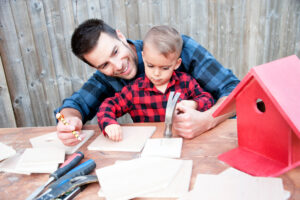The Languages of Love
In my last blog, I spoke about spending meaningful time with our kids, but what does it mean to spend meaningful time? I think meaningful time means that the other person walks away feeling loved. How do we communicate this love?

Dr. Gary Chapman saw that people received love in different ways, and if love was not expressed to someone in a certain way that was meaningful to them, then they would say they did not feel loved. If my Greek neighbor came over to deliver a message, but he delivered the message in Greek, I would thank him for coming over, but would have no idea what he was trying to say or communicate. I would need him to speak my language so that I could receive his message. Dr. Chapman created the idea of a love language to help us communicate love to others, writing several books about how to speak the “Five Love Languages.” Let’s take a look to see how Dr. Chapman says we can use these “love languages” to tell our kids we love them in a way that they will understand.
According to the theory creator, there are five love languages: words of affirmation, acts of service, quality time, gifts, and physical touch. What does this look like in our relationship with kids? And how can we tell what our kids’ love language is?
Well, how does your child show you that they love you? What really makes them light up, or what is it that they dwell on enough to tell their friends and family about?
Words of Affirmation would be saying kind words about another person. In the case of a young child, this love language is also very much about how you communicate the affirmation.
- This can be about their looks, their actions, their behaviors, or their accomplishments. Make sure your affirmations focus on the child.
- Be specific (not “you’re a good kid.” Instead, “I like how you shared your toy with your brother”)
- Use a gentle, kind tone of voice to communicate a tone of love with your words.
- Make sure you’re using different affirmations. Otherwise, your child could become anxious if you don’t praise them every time they perform the behavior you praise.
 Physical touch is hugs, kisses, cuddles, hand holding, but also wrestling, high fives, riding on shoulders, throwing kids up in the air, or on the bed. This can look like typical affection, but will also involve physical activity like tackling or dog piling, as this is how some children, particularly boys, form and deepen relationships.
Physical touch is hugs, kisses, cuddles, hand holding, but also wrestling, high fives, riding on shoulders, throwing kids up in the air, or on the bed. This can look like typical affection, but will also involve physical activity like tackling or dog piling, as this is how some children, particularly boys, form and deepen relationships.
- Give your child a massage.
- Sit next to them when possible.
- For a child who likes rougher physical touch, give them a big hug, throw them up in the air, let them tackle you, and then tickle them. Tossing a ball around, high fives, fist bumps, putting your arm around them. Allow them to engage in appropriate touching that might be more rough and tumble- it’s good for them when it’s done safely!
Acts of service would look like anything you do to serve your child. I bet you’re thinking -” Isn’t serving them what I do all day anyway?” This is over and above your everyday tasks. I knew my daughter loved acts of service when she thanked me for 2 weeks because I threw a party for her birthday and took her to the Aquarium.
- Help with chores
- Decorate their room or around the house for days that are important to them, like birthdays, Summer Break, Easter, Playoffs for their sport.
- As parents, sometimes our act of service is being patient and letting them do things the hard way, or teaching them something and letting them take 45 minutes to complete what should have been a 5-minute task.
- Making a special meal
- Taking the kids somewhere they’ve wanted to go for a long time could be an act of service.
 Quality time is probably the easiest love language to recognize in others. Does your child beg you to play with them, and do they light up like a tree on Christmas when you play with them? That probably means quality time is their love language.
Quality time is probably the easiest love language to recognize in others. Does your child beg you to play with them, and do they light up like a tree on Christmas when you play with them? That probably means quality time is their love language.
- This time must be dedicated to the child, so no phone.
- Be engaged and present while playing with your child.
- While we’re busy, overwhelmed, or tired, we have to prioritize time with our kids every day, even if it’s just 10 minutes.
- See if you can incorporate something you like into the time. For example, if you like arts and crafts, do a craft together that is low-key, requires little assembly, and that you can work together to complete. If you like reading, read books together before bed.
Receiving a gift is a potential way for a person, including a child, to feel loved. Does your child talk about the gift for a long time? Do they comment on the wrapping, or talk about the gift with other people? Does he like to give other people gifts and put time and effort into even wrapping the gift? Then giving gifts is probably his love language.
- Gifts do not have to be toys. They could be a shell or a card you make, or a flower you pick.
- This is not a reward or a bribe, this is a gift just because you were thinking about your child- and tell them that!
As parents, we may not be comfortable expressing love in the way our kids need. I hate cuddling and hugging. God had a sense of humor when he gave me two children who won’t stop touching me all day. I have to put that aside and not only allow them to touch me, but to give them meaningful affection back.

Some people hate the love languages because they seem very limiting and put people in a box. To me, this is not an exhaustive list of how people could interpret another’s love for them through their words and actions. It’s more ideas for how to personalize and effectively communicate love. We do need to remember that all five languages still need to be expressed to our littles. Even though they receive love in one way, Dr. Chapman says that we need to be incorporating all five of these into our daily lives with our children. And, just like our children are all different, their love languages will vary, even if they are in the same “language.” For example, someone whose love language could be physical touch, expressed by holding hands, hugging tightly, and giving kisses. Another’s love language is also touch, but he likes to be carried around and held all day, and also likes to wrestle, be dragged around by dad’s feet, and to play very roughly in general. They both have physical touch as a love language, but they express it very differently. So, try to see if you can determine your love language, your child’s love language, and what that looks like for both of you. This is one language you won’t need Rosetta Stone for!